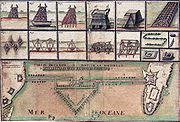
Clément Metézeau
Encyclopedia
Clément Métezeau also Clément II Métezeau, was Royal architect of Louis XIII, and French engineer who completed the seawall
blocking the city of La Rochelle
in the Siege of La Rochelle
in 1627–1628.
The initial idea for blocking the channel leading to the harbour of La Rochelle in order to stop all supplies to the city came from the Italian engineer Pompeo Targone
, but his structure was broken by the winter weather. The endeavour was finally taken up by the Royal architect Clément Métezeau (also Metzeau).
 The wall was built on top of a foundation made of sunken hulks, filled with rubble. The construction involved 4,000 workmen, and the seawall was 1,400 metres long. French artillery installed on the seawall and used against English ships that tried to supply the city.
The wall was built on top of a foundation made of sunken hulks, filled with rubble. The construction involved 4,000 workmen, and the seawall was 1,400 metres long. French artillery installed on the seawall and used against English ships that tried to supply the city.
Métezeau was also involved in the building of the Palais du Luxembourg for Marie de Medicis: he was sent to Florence
by the main architect Salomon de Brosse
to make drawings of the Palazzo Pitti
, which was to be used as a model by the regent's order.
Clément Métezeau also built the Classical facade of the Église Saint-Gervais-Saint-Protais
of Paris, in 1621.
Seawall
A seawall is a form of coastal defence constructed where the sea, and associated coastal processes, impact directly upon the landforms of the coast. The purpose of a seawall is to protect areas of human habitation, conservation and leisure activities from the action of tides and waves...
blocking the city of La Rochelle
La Rochelle
La Rochelle is a city in western France and a seaport on the Bay of Biscay, a part of the Atlantic Ocean. It is the capital of the Charente-Maritime department.The city is connected to the Île de Ré by a bridge completed on 19 May 1988...
in the Siege of La Rochelle
Siege of La Rochelle
The Siege of La Rochelle was a result of a war between the French royal forces of Louis XIII of France and the Huguenots of La Rochelle in 1627-1628...
in 1627–1628.
The initial idea for blocking the channel leading to the harbour of La Rochelle in order to stop all supplies to the city came from the Italian engineer Pompeo Targone
Pompeo Targone
Pompeo Targone was an Italian military engineer in the service of Ambrose Spinola. He was famous for his role in the Siege of Ostend , the Siege of La Rochelle and the Huguenot wars...
, but his structure was broken by the winter weather. The endeavour was finally taken up by the Royal architect Clément Métezeau (also Metzeau).

Métezeau was also involved in the building of the Palais du Luxembourg for Marie de Medicis: he was sent to Florence
Florence
Florence is the capital city of the Italian region of Tuscany and of the province of Florence. It is the most populous city in Tuscany, with approximately 370,000 inhabitants, expanding to over 1.5 million in the metropolitan area....
by the main architect Salomon de Brosse
Salomon de Brosse
Salomon de Brosse was the most influential early 17th-century French architect, a major influence on François Mansart. Salomon was from a prominent Huguenot family, the grandson through his mother of the designer Jacques I Androuet du Cerceau and the son of the architect Jean de Brosse...
to make drawings of the Palazzo Pitti
Palazzo Pitti
The Palazzo Pitti , in English sometimes called the Pitti Palace, is a vast mainly Renaissance palace in Florence, Italy. It is situated on the south side of the River Arno, a short distance from the Ponte Vecchio...
, which was to be used as a model by the regent's order.
Clément Métezeau also built the Classical facade of the Église Saint-Gervais-Saint-Protais
St-Gervais-et-St-Protais Church
The St-Gervais-et-St-Protais Church of Paris sheltered one of the most famous dynasties of French musicians, the Couperin family, for more than two centuries, beginning in 1653....
of Paris, in 1621.

